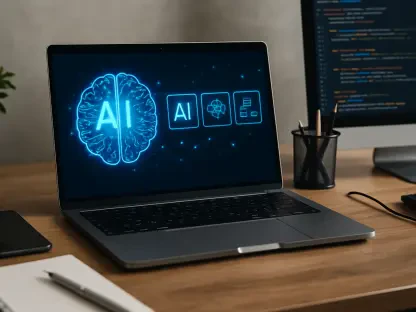The Current Landscape of Software Engineering
In an era where digital transformation dictates the pace of global business, software engineering stands at the forefront of innovation, with over 90% of enterprise applications now built on cloud-native architectures. This staggering shift from traditional on-premise systems to dynamic, scalable environments underscores the critical role of technology in driving efficiency and competitiveness in today’s fast-paced world. The industry today is a vibrant ecosystem, fueled by rapid advancements and the pressing need for organizations to adapt to an increasingly connected world.
Software engineering has become a cornerstone of the digital economy, powering everything from mobile applications to complex enterprise solutions. Key players like Microsoft and GitHub dominate the space, providing tools and platforms that enable developers to create at unprecedented speeds. The growing influence of cloud computing and artificial intelligence (AI) is evident, as these technologies are no longer optional but essential components of modern development practices, reshaping how solutions are designed and deployed.
A notable transition is the move away from monolithic systems toward microservices and container-based architectures in the cloud. Alongside this, AI tools are becoming integral to workflows, assisting with code generation, debugging, and optimization. This convergence of cloud-native practices and intelligent automation signals a profound evolution, setting the stage for a future where speed, scalability, and adaptability define success in software development.
Key Trends and Innovations in Cloud and AI for Software Engineering
Emerging Technologies and Practices
Cloud-native development has emerged as a dominant trend, leveraging microservices, containers, and APIs to build applications that are inherently flexible and resilient. This approach enables organizations to scale operations seamlessly while maintaining agility in deployment cycles. Tools like Kubernetes for container orchestration have become standard, reflecting a broader movement toward modular, distributed systems that prioritize efficiency.
AI-driven solutions are also transforming the development landscape, with platforms like GitHub Copilot offering real-time code suggestions and automating repetitive tasks. These tools not only enhance productivity but also allow developers to focus on higher-level problem-solving and innovation. Additionally, the rise of low-code and no-code platforms such as Mendix and OutSystems is democratizing software creation, enabling non-technical users to contribute to application development and easing the burden on skilled engineers.
The integration of DevOps, CloudOps, and DevSecOps practices further accelerates this transformation, emphasizing automation through Infrastructure as Code (IaC) and real-time monitoring. These methodologies ensure system reliability by reducing manual errors and enabling rapid response to issues. The convergence of these disciplines highlights a shift toward a holistic approach, where collaboration, security, and operational efficiency are embedded in every stage of the development lifecycle.
Market Growth and Future Projections
The adoption of cloud-native applications continues to surge, with the majority of new enterprise software designed for cloud environments as of this year. Industry data reveals a significant impact, including a 70% reduction in deployment failures attributed to cloud-native DevOps practices. This statistic underscores the robustness of modern systems and their ability to handle complex, high-demand workloads with minimal disruption.
Looking ahead from 2025 to 2027, AI is projected to play an even larger role in boosting developer productivity, with tools expected to handle up to 50% of routine coding tasks. Such advancements promise to shorten project timelines and reduce costs, enabling teams to allocate resources to strategic initiatives. The scalability offered by cloud platforms will further drive innovation, allowing businesses to experiment with new ideas without the constraints of traditional infrastructure.
These technologies are set to redefine the competitive landscape, as organizations that harness cloud and AI capabilities gain a distinct edge in speed and adaptability. The focus on automation and intelligent systems is not merely a trend but a fundamental shift, positioning software engineering as a key driver of business transformation across industries in the coming years.
Challenges in Adopting Cloud and AI Technologies
The rapid integration of cloud and AI into software engineering brings with it a host of challenges, notably the persistent skill gap among developers. Many professionals lack expertise in cloud-native tools and AI-driven workflows, creating bottlenecks in adoption. Addressing this requires a concerted effort to provide training and resources, ensuring teams are equipped to navigate the complexities of modern development environments.
Another hurdle lies in managing distributed systems, which are inherently more intricate than their monolithic predecessors. The risk of misconfigurations and performance issues looms large, demanding robust governance and monitoring frameworks. Organizations must invest in solutions that simplify oversight while maintaining the flexibility that cloud architectures offer, balancing innovation with operational stability.
Security concerns also pose significant obstacles, as cloud environments expand the attack surface for potential threats. Compliance with evolving regulations adds another layer of complexity, often straining resources. To mitigate these risks, adopting automation for compliance checks and embedding security practices early in the development process are essential steps toward building resilient and trustworthy systems.
Regulatory and Security Considerations in the Cloud Era
Navigating the regulatory landscape remains a critical aspect of cloud-based software development, with standards like GDPR and HIPAA imposing stringent requirements on data handling. These frameworks demand meticulous attention to privacy and protection, influencing how applications are designed and deployed. Non-compliance can result in severe penalties, making adherence a top priority for organizations operating in multiple jurisdictions.
Emerging security practices offer a path forward, with Zero Trust Architecture gaining traction as a model that assumes no entity is inherently trustworthy. Coupled with AI-powered threat detection, this approach enhances the ability to identify and respond to risks in real time. The concept of “shifting left”—integrating security at the earliest stages of development—further strengthens defenses, ensuring vulnerabilities are addressed before they can be exploited.
Automation plays a pivotal role in managing compliance and risk, streamlining processes that would otherwise be labor-intensive. Tools that continuously monitor for regulatory alignment and potential threats enable proactive management, safeguarding data integrity in cloud ecosystems. This focus on preemptive measures is vital for maintaining trust and reliability in an increasingly interconnected digital environment.
The Future Developer Ecosystem and Industry Outlook
The software engineering field is evolving rapidly, with traditional roles giving way to specialized positions such as AI developers, cloud platform engineers, and DevSecOps specialists. These emerging job categories reflect the growing complexity of technology stacks and the need for expertise in niche areas. As systems become more integrated, professionals must adapt to multidisciplinary demands to remain relevant.
Skill development in cloud-native tools, AI integration, and security-first coding is now a prerequisite for career advancement. Educational initiatives and certifications are becoming critical, equipping developers with the knowledge to handle advanced platforms and methodologies. This trend points to a future where continuous learning is not just encouraged but necessary for staying competitive in a dynamic industry.
Potential disruptors, including further advancements in automation and AI, could reshape the landscape even more profoundly in the near term. Global economic conditions and the pace of technological innovation will also influence how quickly these changes unfold. Organizations and individuals alike must remain agile, ready to pivot in response to new tools, market demands, and unforeseen challenges that lie ahead.
Conclusion: Navigating the Future of Software Engineering
Reflecting on the transformative journey of software engineering, it is clear that cloud computing and AI have become indispensable forces, driving unprecedented speed and scalability across the industry. Their integration into development practices has redefined what is possible, enabling organizations to innovate at a pace that was once unimaginable. The emphasis on automation, from deployment to compliance, has proven to be a cornerstone in managing the complexities of modern systems.
Looking back, the adoption of low-code platforms and security-first approaches has opened doors to broader participation and safer digital environments. As challenges like skill gaps and regulatory demands are tackled through training and proactive strategies, the industry has shown remarkable resilience. The path forward requires a sustained commitment to adaptability, ensuring that both companies and developers continue to evolve with emerging trends.
For actionable next steps, organizations are encouraged to prioritize investment in upskilling programs, focusing on cloud and AI competencies to build a future-ready workforce. Embracing automation tools for security and compliance has become non-negotiable, offering a way to stay ahead of risks while maintaining efficiency. By fostering a culture of innovation and inclusivity, the software engineering community is well-positioned to lead the digital era, turning challenges into opportunities for growth and impact.









